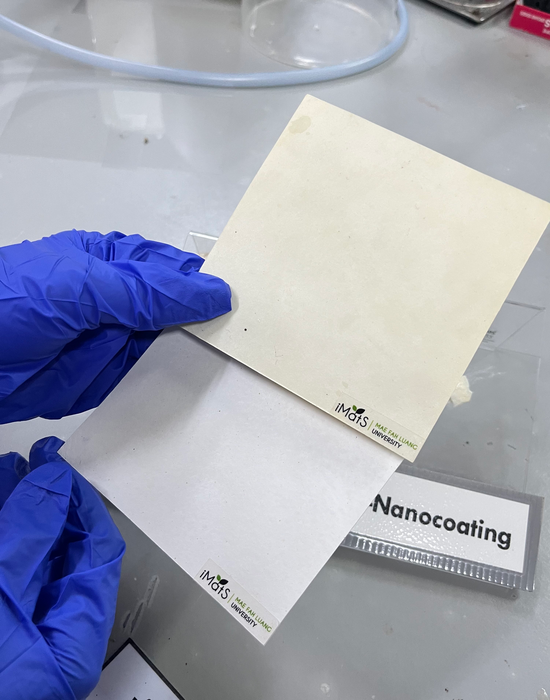Researchers at the Queen Mary University of London and Mae Fah Luang University in Thailand have created a shellac-based coating to enhance the gas barrier properties of a recyclable, compostable, and sustainably sourced packaging material, making it ideal for instant, dehydrated, frozen, and chilled foods.
 Shellac-based coating makes pulp materials suitable for food without use of petroleum-based polymers or metal. Image Credit: Prof Nattakan Soykeabkaew
Shellac-based coating makes pulp materials suitable for food without use of petroleum-based polymers or metal. Image Credit: Prof Nattakan Soykeabkaew
For food serving trays, containers, and beverage carriers, molded pulp manufactured from sustainable resources like sugarcane bagasse or eucalyptus wood is frequently used as a sustainable packaging material.
More than 30% of all paper-based packaging materials are produced using this method, and in addition to using renewable feedstocks, they can also be recycled and composted.
However, the materials’ low gas barrier capabilities and inadequate water and oil resistance render molded pulps unsuitable for preserving the quality and shelf-life of many products.
This is usually fixed by laminating or coating the materials with thin layers of metals, primarily aluminum- and petroleum-based polymers like polyethylene, making recycling or composting impossible.
The study, which was published on February 7th, 2023 in the SCI journal Polymer International, set out to create a new coating made of eco-friendly, renewable, and biodegradable materials to enhance the molded pulp’s barrier properties and surface resistance while maintaining its sustainability.
Shellac has been manufactured from a resin excreted by lac bugs and used to make everything from furniture lacquer to nail polish to different colors. India, Thailand, and China are the biggest manufacturers of shellac, although it is also made in Bangladesh, Myanmar, Laos, Vietnam, and Mexico.
Due to its nontoxic nature, thermoplastic behavior, oil resistance, and effective moisture barrier qualities, it is a biopolymer of the polyester group that is widely employed in the pharmaceutical and food sectors.
It can also be dissolved in low-toxicity solvents and displays an excellent adhesion finish. Pure shellac, however, is not frequently utilized as a covering, due to its high oxygen permeability and brittleness.
In this study, a molded pulp’s barrier and surface resistance performance were enhanced by coating it with a nanocomposite layer made of shellac and nanofibrillated cellulose (NFC).
Modified nanofibrillated cellulose (mNFC) was created via an esterification procedure to improve NFC’s compatibility with the shellac phase and boost its water resistance. For comparison, the researchers also created samples that were not coated and ones that were coated in pure shellac.
The effects of the nanocomposite coating formulation (specifically, nanocellulose content and modification) on the morphology, barrier properties (water vapor transmission rate (WVTR), oil transmission rate (OTR), water and oil resistance, thermal stability, and mechanical properties of the fabricated specimens were systematically investigated.
The researchers found that the water vapor and oxygen transfer rates were comparable to those of low-density polyethylene, oriented polypropylene, and polyethylene terephthalate, which are common materials for food packaging.
According to tests on the water contact angle, oil contact angle, and oil absorption rate, the nanocomposite coating layer gave the molded pulp sheet outstanding water resistance and a potentially greaseproof surface.
The coating layer improved the sheet samples’ tensile qualities as well, particularly for the sample coated with mNFC and shellac. After adding the shellac layer with reduced thermal degradation temperature, the samples acquired good thermal stability (about 250 °C), demonstrating its potential for packaging applications.
Our next aim is to develop a sustainable coating that is cheaper and scalable via materials selection and design as well as some process modifications.
Nattakan Soykeabkaew, Lead Researcher and Professor, School of Science, Mae Fah Luang University
The expense of commercialization is now a hindrance, according to Professor Soykeabkaew, who thinks that it is three to ten times more expensive than materials already in use.
The coating could, according to Professor Soykeabkaew, “be applied on other eco-materials to decrease the water/moisture sensitivity.”
Journal Reference:
Klayya, S., et al. (2023) Sustainable nanocomposite coating for moulded pulp with enhanced barrier properties for food packaging applications. Polymer International. doi:10.1002/pi.6469.